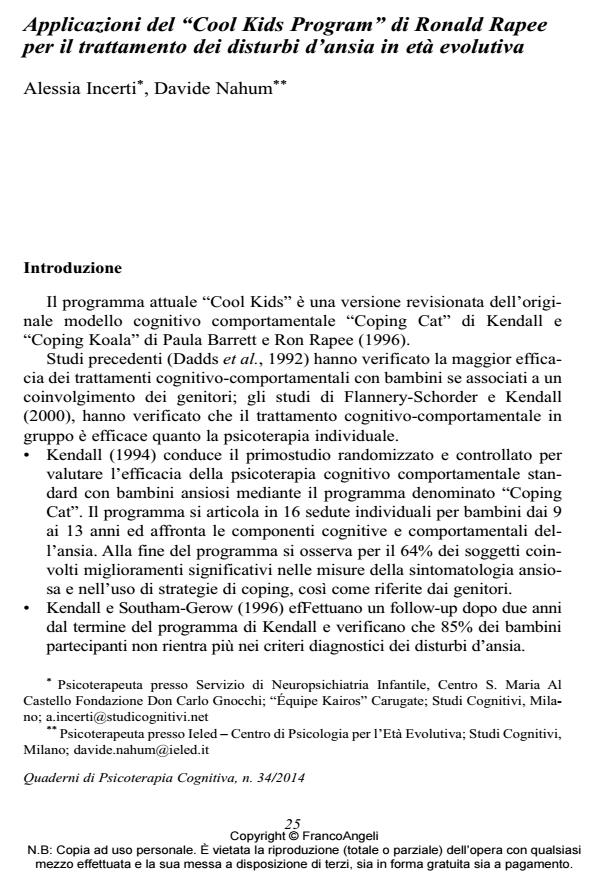Applicazioni del "Cool Kids Program" di Ronald Rapee per il trattamento dei disturbi d’ansia in età evolutiva
Titolo Rivista QUADERNI DI PSICOTERAPIA COGNITIVA
Autori/Curatori Alessia Incerti, Davide Nahum
Anno di pubblicazione 2014 Fascicolo 2014/34
Lingua Italiano Numero pagine 16 P. 25-40 Dimensione file 146 KB
DOI 10.3280/QPC2014-034003
Il DOI è il codice a barre della proprietà intellettuale: per saperne di più
clicca qui
Qui sotto puoi vedere in anteprima la prima pagina di questo articolo.
Se questo articolo ti interessa, lo puoi acquistare (e scaricare in formato pdf) seguendo le facili indicazioni per acquistare il download credit. Acquista Download Credits per scaricare questo Articolo in formato PDF

FrancoAngeli è membro della Publishers International Linking Association, Inc (PILA)associazione indipendente e non profit per facilitare (attraverso i servizi tecnologici implementati da CrossRef.org) l’accesso degli studiosi ai contenuti digitali nelle pubblicazioni professionali e scientifiche
Spesso nei servizi di neuropsichiatria infantile è necessario creare liste d’attesa per la presa incarico dei piccoli pazienti in psicoterapia individuale. Le risorse, infatti, non sono sempre pari al bisogno. Emerge la necessità di appoggiarsi a terapie efficaci in tempi brevi, in setting di gruppo. Tra i modelli presenti in letteratura abbiamo scelto il "Cool Kids Program" di Ronald Rapee, un trattamento evidence based la cui efficacia è basata su ricerche effettuate nell’arco di un decennio nelle seguenti strutture australiane: Macquarie University; Royal North Hosiptal e Queensland University. Si tratta di un trattamento che prevede sia una componente comportamentale (psico-educazione dell’ansia ed esposizioni) sia una componente cognitiva (critica e ristrutturazione dei pensieri). Il programma prevede un alto coinvolgimento dei genitori nel trattamento, come evidenziato da Barret et al. (1996); Mendlowitz et al. (1999); Cobham et al. (1998), i programmi cognitivo-comportamentali mirati ai bambini e con una parte del trattamento che coinvolge i genitori portano a risultati più significativi alla fine del programma e nel follow-up a tre e sei mesi. Il "Cool Kids Program" è un trattamento manualizzato, ossia comprende i manuali con i materiali specifici da usare in terapia per tutti gli attori dell’intervento (psicoterapeuta, bambino, genitori). Nel presente lavoro si descrive il protocollo di trattamento "Cool Kids", il modello teorico di riferimento, la struttura dell’intervento e le metodologie di applicazioni, realizzate dagli Autori in centro pubblico e presso studi privati.
Parole chiave:Psicoterapia cognitivo-comportamentale di gruppo, disturbi d’ansia, bambini, genitori
Alessia Incerti, Davide Nahum, Applicazioni del "Cool Kids Program" di Ronald Rapee per il trattamento dei disturbi d’ansia in età evolutiva in "QUADERNI DI PSICOTERAPIA COGNITIVA" 34/2014, pp 25-40, DOI: 10.3280/QPC2014-034003